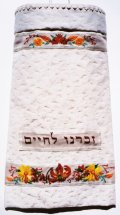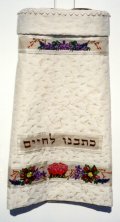Undated, 5763, Jan Fischer
Remember Us for Life
Jan Fisher
|
This article originally appeared in The Paper Pomegranate, a quarterly publication for members of the Pomegranate Guild of Judaic Needlework, and is reprinted by permission. See http://www.pomegranateguild.org. The original article also included material from an article by Karen Friedman that appeared in the Netivot Shalom synagogue newsletter. People interested in membership to the organization can inquire via the website or contact the national membership person: Naomi Novak, Membership Chair |
In early 2000 I was approached by Shira Bell, a member of our synagogue, Netivot Shalom: would I be willing to make two Torah mantles for the High Holy Days? I agreed and was told that I would be paid $500 per mantle. I figured that would cover the materials and I would be able to hire my daughter as the designer with the rest of the money. My husband Don and I went to measure the scrolls so the covers would fit perfectly.
However, before the start of the design process my husband had a stroke. I used the project to help center my life as we started helping my husband in his recovery. Unfortunately, seven months after the stroke he was diagnosed with terminal cancer and died within six weeks. The project took about a year and a half from start to finish. We turned my sewing room into my husband's sick room for about three weeks and it took a while thereafter before I was able to use it for sewing again.
At that point I decided to finish the covers and donate them to the synagogue in memory of Don, who was both a physician and a chazzan (cantor) and who had led high holiday services since his teen years. He and I were among the founders of our synagogue thirteen years ago. Yes, this was the congregation's bar mitzvah year.
Prior to starting the design, I did some research on the art and history of Torah covers. In many cases, the design of a cover reflected the culture and surroundings where it was used. I was intrigued by the designs that reflected the plants of the area in which they were created, and so selected the California wildflower motif. My daughter studied native California flowers and designed the mantles. She made three drawings for each design to help me use the correct colored thread, coding two of the drawings with the DMC color numbers. She also kept an eye on the work in progress. I chose the stitches as I worked. (My daughter also drew a fourth design directly onto the linen for me to stitch over. Yes, if you look hard you can see the ink under the embroidery.) I also had a committee of two artists from the synagogue, Claire Sherman and Danielle Shelley. It helped that they were good friends whose design and color sense I admired. They acted as consultants with scale and placement of the elements of the mantle.
I also studied Torah mantle construction. I decided that ours would have overlapping back flaps. The cylinder enclosing the scroll would be a rectangle attached to the top by Velcro, permitting storage of the wrapper as a flat rectangle when separated from the top. It would also permit dry cleaning if needed. I was fortunate to have a friend,
Reeva Shaffer, who makes Torah mantles professionally and gave me of her time and experience, answering questions that some nonprofessionals ducked. I also had the assistance of a gifted wood worker, Paul Feinstein, who took time out from creating designer wooden bowls to make the inside top support and the roundels which protect the holes. He even glued everything together with removable glue so that when the fabric of the mantle is no longer usable we can reclaim the wood top and protective rings.
I chose upholstery material, "Teflon coated", for the outer body of the mantle. The strips of linen, mounted on a tapestry stretcher while I worked on the embroideries, were then appliqued to the body of the mantle. I am a quilter, accustomed to putting fabrics together. I chose DMC floss as my thread for two main reasons: It has the largest number of available colors, and it can be divided into different numbers of strands to vary the thread size. There was no wool used in the mantles (avoiding the issue of shatnes, the proscription against combining linen and wool fiber). The most common reaction people have when seeing the mantles is to run their hand over the embroidery. I tried to used stitches that would be stable under use, but that wasn't always possible. I went for effect, too.
The two mantles are companion pieces whose decorations are an intricate array of flowers. One cover is embroidered in a red, orange, yellow theme, the other in blue and purple.
 Zochreinu l'chayyim |
 Katveinu l'chayyim |
These lovely flowers were not randomly chosen, but are California native flowers, each incorporated in the design by my daughter for a particular reason. The flowers on the darker, blue and purple mantle can be viewed as representations of the Natural World and on the more vivid, yellow and red mantle, symbols of Humanity. The flowers on the blue/purple mantle represent physical, environmental extremes. There is the heat of the desert, (Bakersfield cactus, Opuntia silaris, California's rarest cactus), and the vast, cold depths of the ocean (Island Mallow, Lavatera assurgentiflora, found on the South Channel Islands). There is the heavenly Dwarf Lupine (Lupinus lepidus), a forest dweller, and the earthy, Santa Ana River Wollystar (Eriastrum densifolium), which lives in a river wash.
As people, we are members of a community, represented by California poppy (Eschscholzia californica), our state flower, which can be found growing in glorious numbers. We are also unique individuals, like the Western Lily (Lilium occidentale), an endangered plant which grows singly. We have exterior lives, as seen with California Indian Pink (Silene californica) which grows exposed on rocky slopes, and interior selves, Canyon Sunflower (Venegasia carpesioides), found protected on wooded slopes. And as they are companion pieces, both mantles have California Fuchsia (Zauschneria californica), Berkeley's flower, to represent us, the community.
These Torah covers are to be used for services from Selichot through Simchat Torah and were first used Erev Rosh Hashanah of 5762 (2001). They are currently hanging in my back closet, but I will return them to the synagogue for Selichot. After Simchat Torah I will again take them to store for the year.
Jan is primarily a quilter who also is experienced with crewel embroidery. She crochets kippot utilizing patterns from knitting books and counted cross stitch books. She is active in Hadassah as well as her synagogue. Jan's sister, Bethaviva Cohen, is also a Pomegranate Guild member. Jan studies Tanakh, teaches Torah reading and haftarah chanting, and has tutored children in Hebrew and B'nai Mitzvah skills.
